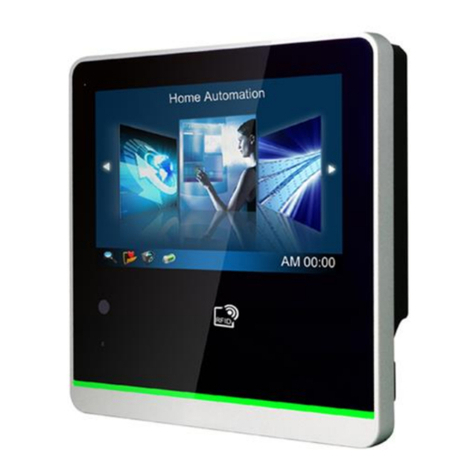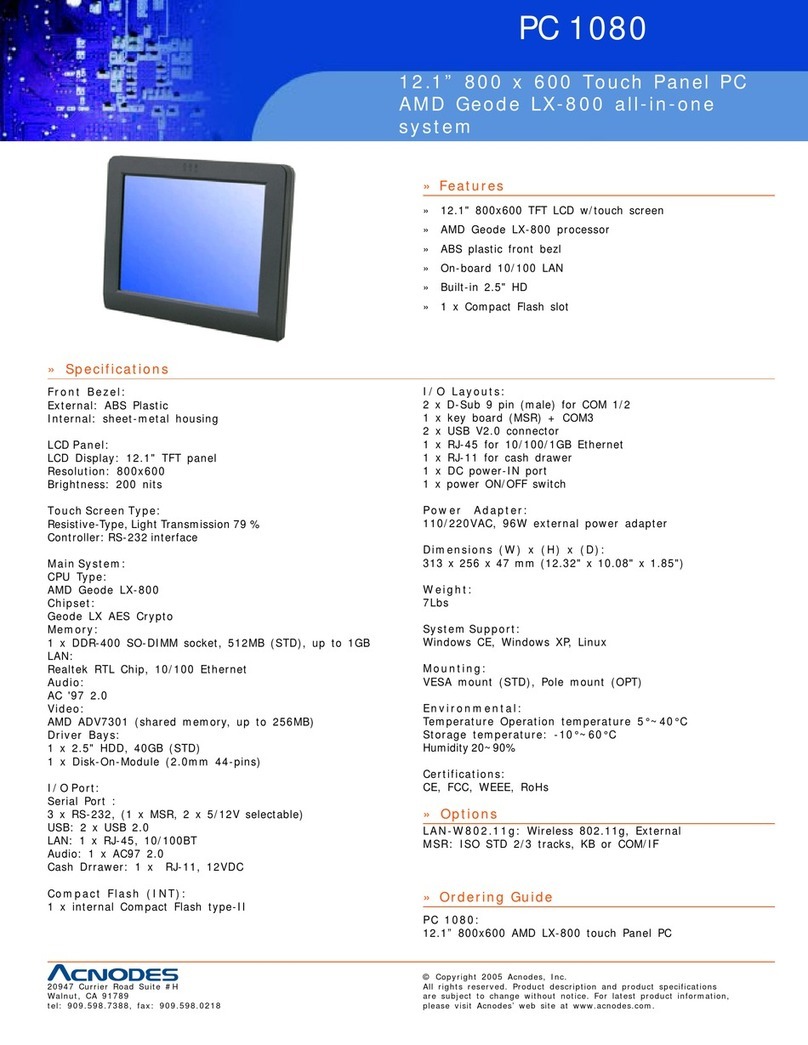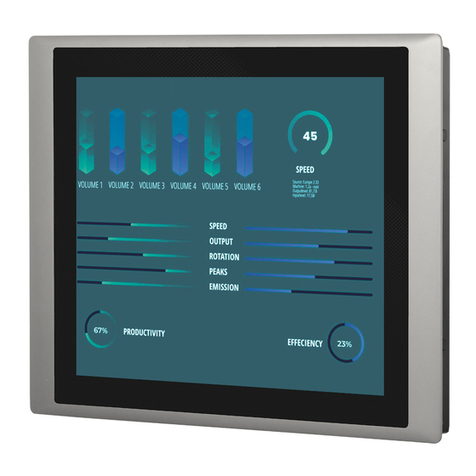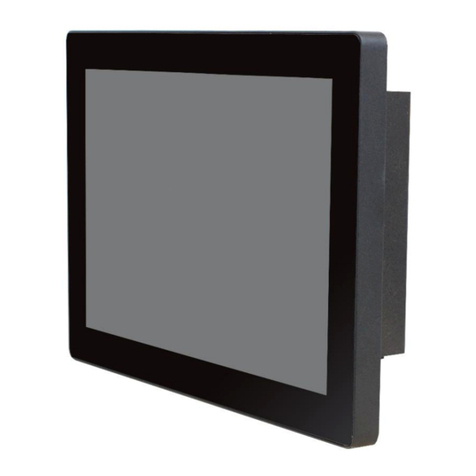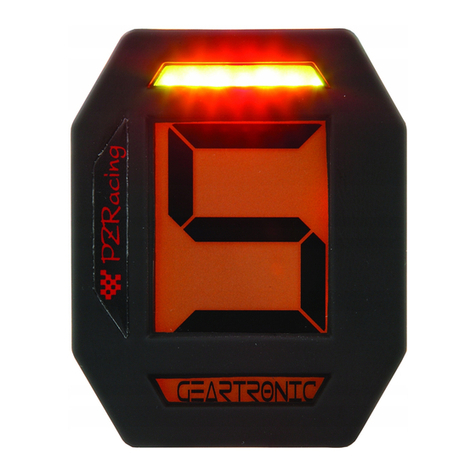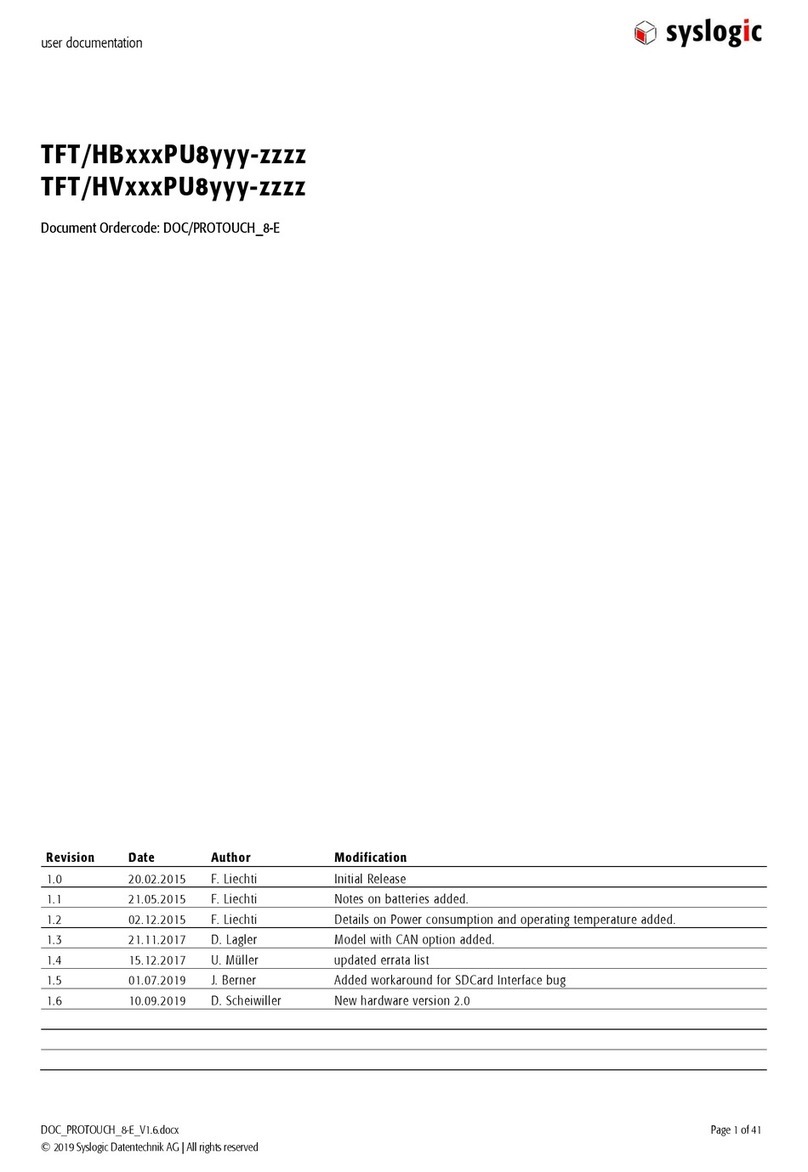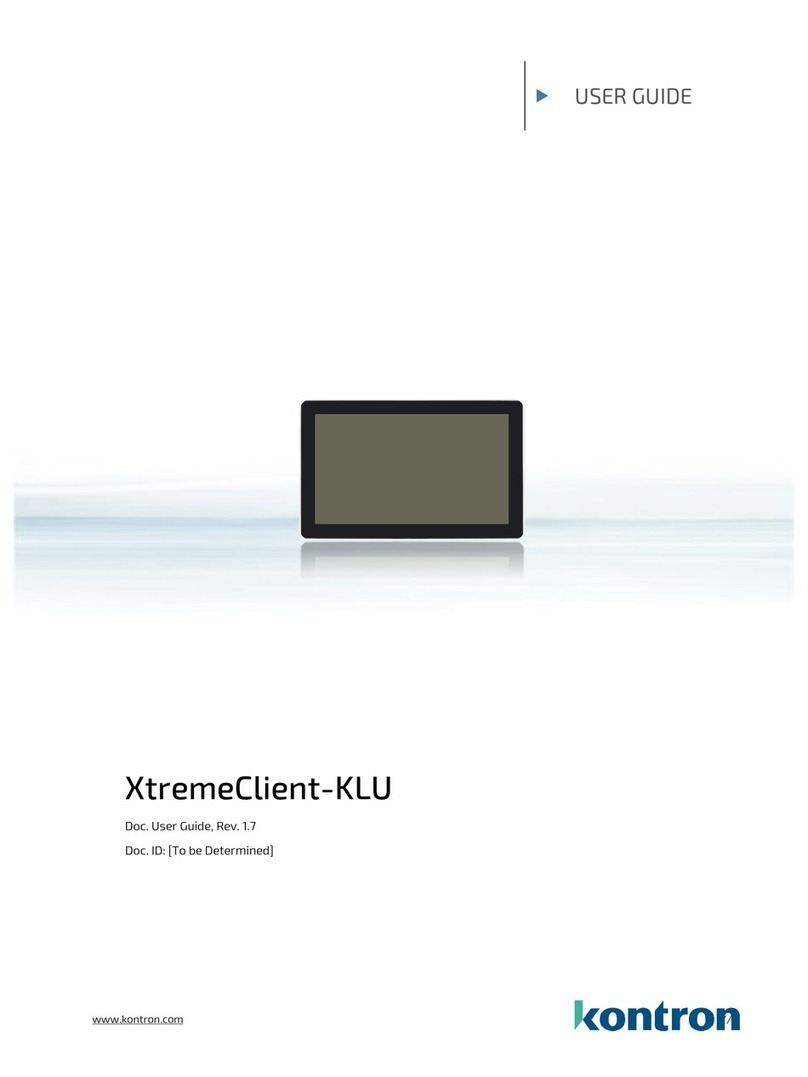IME DG4P User manual

10780631 • 07-2003 3aEd.
Via Travaglia 7
20094 CORSICO (MI)
ITALIA
Tel. 02 44 878.1
Fax 02 4503448
+39 02 45 86 76 63
www.imeitaly.com
info@imeitaly.it
Istruzioni d’Uso
User’ s Guide
Guide d’utilisation
Bedienungsanleitung
DG4P
DG4P
DG4Q
DG4Q
RM3C
RM3C
ISTRUMENTI MISURE ELETTRICHE SpA
ISTRUMENTI MISURE ELETTRICHE SpA
ISTRUMENTI MISURE ELETTRICHE SpA

SUPPLY INPUT
20 21 12
(+) (-) ++
34
++
5
SENSOR OUTPUT
24 23
-+
(option)
15
+
25
+
35
+
43
+
5
45
+
Ch1 200V
Ch2 20V
Ch3 200mV
Ch4 20mA
Ch5 2mA
DG4P • DG4Q 96 x 48mm DIN43700
SUPPLY INPUT
20 21 1214 16
15
2
17 18
1
19
(+) (-) ++
34
++
5
SENSOR
OUTPUT
24 23
-+
(option)
15
+
25
+
35
+
43
+
5
45
+
Ch1 200V
Ch2 20V
Ch3 200mV
Ch4 20mA
Ch5 2mA
S305/138
S305/139
SUPPLY INPUT
20 21 1214 16
15
2
17 18
1
19
(+) (-) ++
34
++
5
15
+
25
+
35
+
43
+
5
45
+
Ch1 200V
Ch2 20V
Ch3 200mV
Ch4 20mA
Ch5 2mA
S260/14
100 110
75
5
35
RM3C
RM3C 100 x 110mm
1

10780631 • 07-2003 3 Ausgabe 10780631 • 07-2003 3aEd.
Indice
I.M.E. S.p.A. si riserva in qualsiasi momento, di modificare le caratteristiche tecniche senza darne preavviso.
Descrizione frontale 3
Parametri programmabili 4
Visualizzazione 5
Istruzioni per l’installazione 2
210Am Display erscheint rEL
221Durch Drücken von
▲
,erscheint am Display der Relaistyp.
aWenn der angezeigte Typ der gewünschte ist, drücken Sie PgUp
um die Programmierung fortzusetzen (siehe Punkt 23)
bWenn Sie den Typ ändern wollen, können Sie mit der Taste
▲
den gewünschten Typ wählen und mit PgUp abschließen.
230Am Display erscheint SEt
241Durch Drücken von
▲
,erscheint am Display der Grenzwert
(Alarmschwelle)
aWenn der angezeigte Wert der gewünschte ist, drücken Sie
PgUp um die Programmierung fortzusetzen (siehe Punkt 25)
bWenn Sie den Wert ändern wollen, können Sie mit den Tasten
▲
und
▼
den gewünschten Wert einstellen und mit PgUp abschließen.
250Am Display erscheint HYS
261Durch Drücken von
▲
,erscheint am Display die Hysterese (Schaltschwelle)
aWenn der angezeigte Wert der gewünschte ist, drücken Sie
PgUp um die Programmierung fortzusetzen (siehe Punkt 27).
bWenn Sie den Wertändernwollen, können Sie mit den Tasten
▲
und
▼
den gewünschten Wert einstellen und mit PgUp abschließen.
270Am Display erscheint dEL
281Durch Drücken von
▲
,erscheint am Display die eingestellte verzögerung.
aWenn der angezeigte Wert der gewünschte ist, drücken Sie
PgUp um die Programmierung fortzusetzen (siehe Punkt 29).
bWenn Sie den Wertändernwollen, können Sie mit den Tasten
▲
und
▼
den gewünschten Wert einstellen und mit PgUp abschließen.
290Am Display erscheint End,drücken Sie gleichzeitig
▲▼
um die
Programmierung zu bestätigen
300Am Display erscheint Sto; das Gerät speichertdie Einstellung und
verläßt das Menü. ■
Italiano
Programmazione 6
Allarmi 11
2

10780631 • 07-2003 3aEd. 10780631 • 07-2003 3 Ausgabe
Deutsch
La posizione di fissaggio (grado di inclinazione) risulta completamente
indifferente ai fini del funzionamento.
Prima di procedere all’installazione, accertarsi che i dati di targa corrispondano
aquelli richiesti (tipo di ingresso, valore di alimentazione ausiliaria, ecc.).
Nei cablaggi rispettare scrupolosamente lo schema di inserzione, una inesat-
tezza nei collegamenti è inevitabile causa di misure falsate o di danni allo
strumento.
Nei collegamenti evitare di disporre i cavi parallelamente a conduttori di
potenza o in prossimità di sorgenti di campi elettromagnetici intensi
(es. grossi trasformatori, teleruttori, ecc.).
Per l’ingresso di misura utilizzare preferibilmente cavi schermati.
Nei modelli DG4P2 • DG4Q2 (con allarmi) • RM3C la posizione dei contatti
indicata nello schema, si riferisce allo strumento non alimentato. ■
Istruzioni per l’installazione
In den Menüs AL.1 und AL.2 können zwei Alarme parametriert werden.
Für jeden Alarm können Sie einstellen:
•tYP ALARMTYP
Hi =max. oder
Lo =min.
•rEL AUSGANGSRELAIS
n.E =normalerweise angezogen oder
n.d =normalerweise abgefallen
•SEt SCHWELLE
-1999…1999 (DG4P - RM3C)
0...9999 (DG4Q)
•HYS HYSTERESE
-1999…1999 (DG4Q)
0...9999
•dEL EINSATZVERZÖGERUNG
0…60 =0…60 Sekunden
180Drücken Sie solange auf PgUp bis AL.1 dargestellt wird
190Drücken Sie gleichzeitig
▲▼
Am Display erscheint PAS und danach Typ
201Durch Drücken von
▲
erscheint am Display der Alarmtyp
(Hi max., Lo min.)
aWenn der angezeigte Typ der gewünschte ist, drücken Sie PgUp
um die Programmierung fortzusetzen (siehe Punkt 21).
bSWenn Sie den Typ ändernwollen, können Sie mit der Taste
▲
den gewünschten Typ wählen und mit PgUp abschließen. 1111
Italiano
Alarmas
H
3

10780631 • 07-2003 3 Ausgabe 10780631 • 07-2003 3aEd.
Italiano
1 • FRONTALE PROTEZIONE IP50 EN60529 (DG4P/DG4Q)
In opzione è disponibile protezione frontale IP54.
2 • DISPLAY
Display a LED rossi, massima indicazione –1999…1999 (DG4P/RM3C) e
0…9999 (DG4Q).
3 • TASTIERA
3 tasti utilizzati per la configurazione oppure la selezione della visualizzazione
(valore istantaneo, valore di picco, stato allarmi).
4 • LED SEGNALAZIONE ALLARMI
L’accensione indica l’avvenuto intervento di uno o di entrambi gli allarmi
(entrando nel menù è possibile visualizzare lo stato allarmi, verificando se
uno o entrambi i relè sono in condizione di anomalia).
Al rientro dalla condizione di anomalia/e, il LED si spegne automaticamente.
5 • ETICHETTA ADESIVA UNITA’ INGEGNERISTICA
Personalizzabile dall’utente.
Con lo strumento vengono fornite 18 etichette adesive con le unità ingegneri-
stiche più comuni. ■
33
Descrizionee frontale
151Durch Drücken von
▲
, erscheint am Display der Endwert des Anzeige-
bereiches.
aWenn der angezeigte Wert der gewünschte ist, drücken Sie
PgUp um die Programmierung fortzusetzen (siehe Punkt 16)
bWenn Sie den Wert ändern wollen, können Sie mit den Tasten
▲
und
▼
den gewünschten Wert einstellen und mit PgUp
abschließen.
160Am Display erscheint End; drücken Sie gleichzeitig
▲▼
um die
Programmierung zu bestätigen.
170Am Display erscheint Sto; das Gerät speichert die Einstellung und
verläßt das Menü. ■
4

10780631 • 07-2003 3aEd. 10780631 • 07-2003 3 Ausgabe
Deutsch
InP / canale d’ingresso (portata)
La scelta del canale di ingresso (e quindi della portata) viene effettuata su
due livelli, connessione (morsetti d’ingresso) e attraverso la programmazione
da tastiera.
• I canali di ingresso disponibili sono 5
Ch1 portata 200V (Un)
Ch2 portata 20V (Un)
Ch3 portata 200mV (Un)
Ch4 portata 20mA (In)
Ch5 portata 2mA (In)
dSP / campo di misura e visualizzazione
Permette di selezionare (all’interno della portata scelta) gli effettivi valori
del campo di misura e di associare loro la visualizzazione desiderata.
• Inizio campo di misura
• Fine campo di misura
• Visualizzazione corrispondente all’inizio del campo di misura
• Visualizzazione corrispondente alla fine del campo di misura
• Punto decimale (XX.XX oppure XXX.X oppure XXXX)
AL.1 • AL.2 / allarmi
• Tipo minima o massima
• Stato relè normalmente eccitato o diseccitato
• Soglia -1999…1999 digit - 0...9999 (DG4Q)
• Isteresi (punto di ripristino) -1999…1999 digit - 0...9999 (DG4Q)
• Ritardo intervento 0…60 secondi. ■
ANZEIGE
40Drücken Sie PgUp; am Display erscheint InP
50Drücken Sie noch einmal PgUp; am Display erscheint dSP
60Drücken Sie gleichzeitig
▲▼
Am Display erscheint PAS und danach L.In (Beginn des Meßbereiches)
71Durch Drücken von
▲
erscheint am Display der Anfangswert des
Meßbereiches.
aWenn der angezeigte Wert der gewünschte ist, drücken Sie
PgUp um Programmierung fortzusetzen (siehe Punkt 8)
bWenn Sie den Wert ändern wollen, können Sie mit den Tasten
▲
und
▼
den gewünschten Wert einstellen und mit PgUp abschließen
dann drücken Sie PgUp
80Im Display erscheint H.In (Ende des Meßbereiches).
91Durch Drücken von
▲
, erscheint am Display der Endwert des
Meßbereiches.
aWenn der angezeigte Wert der gewünschte ist, drücken Sie
PgUp um Programmierung fortzusetzen (siehe Punkt 10).
bWenn Sie den Wert ändern wollen, können Sie mit den Tasten
▲
und
▼
den gewünschten Wert einstellen und mit PgUp abschließen.
100Im Display erscheint dP. (Komma).
111Durch Drücken von
▲
erscheint am Display der Dezimalpunkt.
aWenn die Kommastellung die gewünschte ist, drücken Sie PgUp
um die Programmierung fortzusetzen (siehe Punkt 12)
bWenn Sie das Komma ändern wollen, können Sie mit der Taste
▲
die gewünschte Stellung auswählen und mit PgUp abschließen.
120Im Display erscheint L.dS (Anfang des Anzeigebereiches)
131Durch Drücken von
▲
erscheint am Display der Anfangswert des
Anzeigebereiches.
aWenn der angezeigte Wert der gewünschte ist, drücken Sie
PgUp um die Programmierung fortzusetzen (siehe Punkt 14)
bWenn Sie den Wert ändern wollen, können Sie mit den Tasten
▲
und
▼
den gewünschten Wert einstellen und mit PgUp abschließen.
140Im Display erscheint H.dS (Ende des Anzeigebereiches)
Deutsch
99
Parametri programmabili
Italiano
H
5
5

10780631 • 07-2003 3 Ausgabe 10780631 • 07-2003 3aEd.
Italiano
Oltre al valore istantaneo misurato, è possibile visualizzare il valore massimo
letto (picco massimo) e lo stato degli allarmi (“On” = condizione di allarme
oppure “OFF” = condizione di sorveglianza).
VALORE DI PICCO
Durante il normale funzionamento, premendo il tasto
▲
è possibile visualizzare
il valore massimo misurato.
Tenendo premuto il tasto
▲
per 5 secondi circa, si effettua l’azzeramento
del valore di picco “rS.P”.
L’azzeramento avviene automaticamente anche allo spegnimento dello
strumento (assenza alimentazione ausiliaria) oppure al cambiamento della pro-
grammazione del segnale di ingresso o della visualizzazione.
SEGNALAZIONE ALLARMI
Al superamento di una o di entrambe le soglie predisposte, avviene l’accensio-
ne del led “AL”.
Premere ripetutamente PgUp fino a visualizzare rL.A
Premere contemporaneamente
▲▼
.
Sul display appare PAS seguito da AL.1
Premendo
▲
viene visualizzato lo stato dell’allarme 1
On = condizione di allarme in corso
OFF = condizione normale
Premendo PgUp viene visualizzato AL.2
Premendo
▲
viene visualizzato lo stato dell’allarme 2
On = condizione di allarme in corso
OFF = condizione normale
Premendo PgUp viene visualizzato End
Premere contemporaneamente
▲▼
.
Sul display appare Sto e lo strumento esce automaticamente dalla program-
mazione. ■
55
BEREICH
Hier wird der benötigte Meßbereich festgelegt: 5 Bereiche (Kanäle) sind
verfügbar
Ch1 Bereich 200 für Eingänge zwischen
-50…50V und -200…200V (DG4P, RM3C)
0…50V und 0…200V (DG4Q)
Ch2 Bereich 20V für Eingänge zwischen
-5…5V und -20…20V oder 1…5V (DG4P, RM3C)
0…5V und 0…20V oder 1…5V (DG4Q)
Ch3 Bereich 200mV für Eingänge zwischen
-50…50mV und -200…200mV (DG4P, RM3C)
0…50mV und 0…200mV (DG4Q)
Ch4 Bereich 20mA für Eingänge zwischen
-5…5mA und -20…20mA oder 4…20mA (DG4P, RM3C)
0…5mA und 0…20mA oder 4…20mA (DG4Q)
Ch5 Bereich 2000µA (2mA) für Eingänge zwischen
-500…500µA und -2000…2000µA (DG4P, RM3C)
0…500µA und 0…2000µA (DG4Q)
ACHTUNG:
Die Programmierung des Kanals Ch5 (2mA) wird in µA (2000µA) ausgedrückt
Der Meßbereich wird sowohl durch die Programmierung als auch durch den
Anschluß festgelegt (siehe Anschlußbild).
10Drücken Sie PgUp; Am Display erscheint InP. Drücken Sie gleichzeitig
▲▼
Am Display erscheint PAS und danach Ch.1 (oder der gespeicherte Kanal).
20Drücken Sie solange auf PgUp bis der gewünschte Kanal dargestellt
wird. Drücken Sie noch einmal PgUp, um End darzustellen.
30Drücken Sie gleichzeitig
▲▼
. Am Display erscheint Sto; das Gerät spei-
chert die Einstellung und verläßt das Menü.
H
Visualizzazione
6

10780631 • 07-2003 3aEd. 10780631 • 07-2003 3 Ausgabe
Grazie ai menù InP e dSP è possibile selezionare il valore del segnale da
misurare e la corrispondente visualizzazione.
La programmazione avviene su tre fasi successive:
Canale di ingresso • Campo di misura • Visualizzazione
1 • Canale di ingresso
Selezionare il canale entro i cui valori è compreso il segnale da misurare
Menù InP
Ch. canale di ingresso
2 • Campo di misura
Programmare gli esatti valori di inizio e fine campo di misura (inizio efondo scala)
Menù dSP
L.In valore inizio campo di misura
H.In valore finale campo di misura
3 • Visualizzazione
Programmare i valori da visualizzare in corrispondenza del campo di misura
Menù dSP
dP. punto decimale visualizzazione
L.dS valore da visualizzare in corrispondenza dell’inizio del
campo misura (L.In)
H.dS valore da visualizzare in corrispondenza della fine del
campo misura (H.In)
Beispiel Eingang – 150…0…150V entsprechend – 16,50…0…16,50kW
Ch. = Ch.1 (-200…0…200V)
L.In = -150,0
H.In = 150,0
dP. = 0,00
L.dS = -16,50
H.dS = 16,50
Beispiel Eingang 0…8,5V entsprechend 0…1250 Umdrehungen pro Minute
Ch. = Ch.2 (-20…0…20V)
L.In = 0,00
H.In = 8,50
dP. = 000
L.dS = 0000
H.dS = 1250
Beispiel Eingang – 60…0…60mV entsprechend – 1800…0…1800A
Ch. = Ch.3 (-200…0…200mV)
L.In = -60,0
H.In = 60,0
dP. = 000
L.dS = -1800
H.dS = 1800
Beispiel Eingang 4…20mA entsprechend – 100,0…100,0 kg
Ch. = Ch.4 (-20…0…20mA)
L.In = 4,00
H.In = 19,99
dP. = 00,0
L.dS = -100,0
H.dS = 100,0
Deutsch
77
Italiano
Programmazione
H
H
7

10780631 • 07-2003 3 Ausgabe 10780631 • 07-2003 3aEd.
Italiano
77
Esempio ingresso –150…0…150V corrispondenti a –16,50…0…16,50kW
Ch. = Ch.1 (-200…0…200V)
L.In = -150,0
H.In = 150,0
dP. = 0,00
L.dS = -16,50
H.dS = 16,50
Esempio ingresso 0…8,5V corrispondenti a 0…1250 giri/min
Ch. = Ch.2 (-20…0…20V)
L.In = 0,00
H.In = 8,50
dP. = 000
L.dS = 0000
H.dS = 1250
Esempio ingresso –60…0…60mV corrispondenti a –1800…0…1800A
Ch. = Ch.3 (-200…0…200mV)
L.In = -60,0
H.In = 60,0
dP. = 000
L.dS = -1800
H.dS = 1800
Esempio ingresso 4…20mA corrispondenti a –100,0…100,0 kg
Ch. = Ch.4 (-20…0…20mA)
L.In = 4,00
H.In = 19,99
dP. = 00,0
L.dS = -100,0
H.dS = 100,0 H
Programmierung
Durch die Menüs InP und dSP ist es möglich den Signalwert zu messen
und die entsprechende Anzeige zu wählen.
Die Programmierung erfolgt in drei Schritten:
Eingangskanal • Meßbereich • Anzeige.
1 • Eingangskanal
Wählen Sie den Kanal, der dem zu messenden Eingangssignal entspricht.
Menü InP
Ch. Eingangskanal
2 • Meßbereich
Programmieren Sie den entsprechenden Anfangs- und Endwert des Meßsignals
(Beginn- und Endskala)
Menü dSP
L.In Beginnwert des Meßbereiches
H.In Endwert des Meßbereiches
3 • Anzeige
Programmieren Sie den gewünschten Anfangs- und Endwert des Anzeigebe-
reiches.
Menü dSP
dP. Dezimalpunkt
L.dS Anfangswert des Anzeigebereiches entsprechend dem
Anfangswert des Meßbereiches. (L.In)
H.dS Endwert des Anzeigebereiches entsprechend dem
Endwert des Meßbereiches. (H.In)
H
8

Außer dem gemessenen Momentanwert, ist es möglich den Höchstwert
(Höchstspitze) und den Alarmzustand ("On“ oder "OFF“) darstellen.
HÖCHSTSWERT
Während der normalen Anzeige kann durch Drücken die Taste
▲
der gemesse-
ne Maximalwert angezeigt werden.
Durch Halten der Taste
▲
für ungefähr 5 Sekunden kann man den Spitzenwert
rücksetzen “rS.P”.
Die Rücksetzung erfolgt automatisch auch beim Ausschalten des Gerätes
(keine Hilfsspannung) oder bei der Änderung der Eingangssignalprogrammie-
rung oder der Anzeige.
WARNMELDUNG
Bei der Überschreitung einer oder beider eingestellten Alarmschwellen,
schaltet die LED "AL“ ein.
Drücken Sie wiederholt die Taste PgUp bis rL.A dargestellt wird.
Drücken Sie gleichzeitig die Tasten
▲▼
Am Display erscheint PAS und danach AL.1.
Durch Drücken der Taste
▲
wird der Alarmzustand 1 dargestellt.
On = Auslösung
OFF = Ruhezustand
Am Display erscheint PgUp und danach AL.2.
Durch Drücken der Taste
▲
wird der Alarmzustand 2 dargestellt.
On = Auslösung
OFF = Ruhezustand
Durch Drücken der Taste PgUp erscheint End im Display.
Drücken Sie gleichzeitig die Tasten
▲▼
.
Am Display erscheint Sto und das Menü wird verlassen. ■
10780631 • 07-2003 3aEd. 10780631 • 07-2003 3 Ausgabe
Italiano
PORTATA
Permette di selezionare la portata desiderata, sono disponibili 5 portate (canali)
Ch1 portata 200V per ingressi compresi tra
-50…50V e -200…200V (DG4P, RM3C)
0…50V e 0…200V (DG4Q)
Ch2 portata 20V per ingressi compresi tra
-5…5V e -20…20V opp. 1…5V (DG4P, RM3C)
0…5V e 0…20V opp. 1…5V (DG4Q)
Ch3 portata 200mV per ingressi compresi tra
-50…50mV e -200…200mV (DG4P, RM3C)
0…50mV e 0…200mV (DG4Q)
Ch4 portata 20mA per ingressi compresi tra
-5…5mA e -20…20mA opp. 4…20mA (DG4P, RM3C)
0…5mA e 0…20mA opp. 4…20mA (DG4Q)
Ch5 portata 2000µA (2mA) per ingressi compresi tra
-500…500µA e -2000…2000µA (DG4P, RM3C)
0…500µA e 0…2000µA (DG4Q)
ATTENZIONE:
La programmazione del canale Ch5 (2mA) é espressa in µA (2000µA)
La selezione della portata deve essere effettuata sia tramite programmazione
da tastiera, sia attraverso la connessione dei morsetti d’ingresso (vedi schema).
10Premere PgUp sul display appare InP
Premere contemporaneamente
▲▼
Sul display appare PAS seguito da Ch.1 (o dal canale memorizzato)
20Agire ripetutamente su PgUp fino a visualizzare il canale desiderato.
Premere ancora una volta PgUp per far apparire End
30Premere contemporaneamente
▲▼
sul display appare Sto lo strumento
memorizza l’impostazione ed esce automaticamente dal menù di pro-
grammazione.
H
Anzeige
Deutsch
55
9

10780631 • 07-2003 3 Ausgabe 10780631 • 07-2003 3aEd.
Italiano
99
VISUALIZZAZIONE
40Premere PgUp sul display appare InP
50Premere nuovamente PgUp sul display appare dSP
60Premere contemporaneamente
▲▼
Sul display appare PAS seguito da L.In (inizio campo misura)
71Premendo una volta
▲
sul display viene visualizzato il valore di inizio
del campo di misura.
aSe il valore visualizzato corrisponde a quello desiderato, premere
PgUp e continuare la programmazione (vedi p.to 8)
bSe si desidera modificare il valore, agire su
▲
oppure
▼
fino ad
ottenere quello desiderato, quindi premere PgUp
80Sul display appare H.In (fine campo misura)
91Premendo una volta
▲
sul display viene visualizzato il valore di fine
campo di misura.
aSe il valore visualizzato corrisponde a quello desiderato, premere
PgUp e continuare la programmazione (vedi p.to 10)
bSe si desidera modificare il valore, agire su
▲
oppure
▼
fino ad
ottenere quello desiderato, quindi premere PgUp
100Sul display appare dP (virgola)
111Premendo una volta
▲
sul display viene visualizzato il punto decimale
aSe la posizione della virgola corrisponde a quella desiderata, premere
PgUp e continuare la programmazione (vedi p.to 12)
bSe si desidera modificarne la posizione, agire su
▲
fino ad ottenere
quella desiderata, quindi premere PgUp
120Sul display appare L.dS (visualizzazione inizio scala)
131Premendo una volta
▲
sul display viene visualizzato il valore di inizio
scala
aSe il valore visualizzato corrisponde a quello desiderato, premere
PgUp e continuare la programmazione (vedi p.to 14)
bSe si desidera modificare il valore, agire su
▲
oppure
▼
fino ad
ottenere quello desiderato, quindi premere PgUp
140Sul display appare H.dS (visualizzazione fondo scala)
H
Programmierbare Parameter
InP / Eingangskanal (Bereich)
Die Wahl des Eingangskanals (und daher des Bereiches) iwird durch zwei
Einstellungen getroffen: Verbindung (Eingangsklemmen) und durch die
Tastaturprogrammierung.
• Es gibt 5 verfügbare Eingangskanäle
Ch1 Bereich 200V (Un)
Ch2 Bereich 20V (Un)
Ch3 Bereich 200mV (Un)
Ch4 Bereich 20mA (In)
Ch5 Bereich 2mA (In)
dSP / Meßbereich und Anzeige
Hier werden die tatsächlichen Meßbereichsendwerte und die
Anzeigebereiche eingestellt (im jeweils gewählten Eingangskanal).
• Meßbereichsbeginn
• Meßbereichsende
• Anzeige entsprechend dem Meßbereichsbeginn
• Anzeige entsprechend dem Meßbereichsende
• Dezimalpunkt (XX.XX oder XXX.X oder XXXX)
AL.1 • AL.2 / Alarme
• Typ min. oder max.
• Relaiszustand normalerweise angezogen oder abgefallen
• Schwelle -1999…1999 digit - 0...9999 (DG4Q)
• Hysterese (Wiederanlaufspunkt) -1999…1999 digit - 0...9999 (DG4Q)
• Einsatzverzögerung 0…60 Sekunden. ■
10

10780631 • 07-2003 3aEd. 10780631 • 07-2003 3 Ausgabe
Deutsch
Italiano
33
151Premendo una volta
▲
sul display viene visualizzato il valore di fondo
scala
aSe il valore visualizzato corrisponde a quello desiderato, premere
PgUp e continuare la programmazione (vedi p.to 16)
bSe si desidera modificare il valore, agire su
▲
oppure
▼
fino ad
ottenere quello desiderato, quindi premere PgUp
160Sul display appare End, premere contemporaneamente
▲▼
per
confermare la programmazione effettuata
170Sul display appare Sto
Lo strumento memorizza l’impostazione ed esce automaticamente
dal menù di programmazione. ■
Frontscheibenbeschreibung
1 • IP50 FRONTSCHUTZ EN60529 (DG4P/DG4Q)
Option IP54 Frontschutz.
2 • ANZEIGE
Rote LED Anzeige, Höchstanzeige –1999…1999 (DG4P/RM3C) und
0…9999 (DG4Q).
3 • TASTATUR
3 Tasten werden für die Konfiguration oder die Darstellungswahl
(Momentanwert, Spitzenwert und Alarmzustand) benötigt.
4 • WARNMELDUNGS-LED
Signalisiert, ob einer der beiden Alarme ausgelöst hat (im Menü kann der
Alarmzustand dargestellt werden und die Relaiszustände kontrolliert werden).
Wenn die Alarmschwelle unterschritten wird, erlischt die LED selbständig.
5 • SELBSTKLEBENDE BESCHRIFTUNGEN
Kundenspezifisch anpaßbar. Mit dem Gerät werden 18 meist benötigten
Beschriftungseinheiten geliefert. ■
11

10780631 • 07-2003 3 Ausgabe 10780631 • 07-2003 3aEd.
Con i menù AL.1 e AL.2 è possibile impostare 2 allarmi.
Per ogni singolo allarme occorre impostare:
• tYP TIPO ALLARME
Hi = massima oppure
Lo = minima
• rEL RELÈ USCITA
n.E = normalmente eccitato oppure
n.d = normalmente diseccitato
• SEt SOGLIA
-1999…1999 (DG4P - RM3C)
0...9999 (DG4Q)
• HYS ISTERESI
-1999…1999 (DG4Q)
0...9999
• dEL RITARDO INTERVENTO
0…60 = 0…60 secondi
180Premere ripetutamente PgUp fino a visualizzare sul display AL.1
190Premere contemporaneamente
▲▼
sul display appare PAS seguito
da tYP
201Premendo una volta sul display viene visualizzato il tipo di allarme
(Hi massima, Lo minima)
aSe il tipo visualizzato corrisponde a quello desiderato, premere
PgUp e continuare la programmazione (vedere p.to 21)
Die Einbaulage (Neigungsgrad) hat keinen Einfluß auf die Funktion.
Bevor DG4P • DG4Q eingebaut wird, muß das Typenschild mit den tatsächli-
chen Netzgegebenheiten verglichen werden (Eingangstyp, Hilfsspannungswert,
usw.)
Der Anschluß erfolgt gem. Anschlußbilder. Falschanschluß führt zu erheblichen
Anzeigefehlern! Es können sogar Beschädigungen auftreten.
Vermeiden Sie die Verlegung der Kabel nebe stromführenden Leitern oder
Geräten mit großem elektromagnetischen Feld (Transformatoren,Fernschalter,
usw.).
Für den Meßeingang verwenden Sie vorzugsweise abgeschirmte Kabel.
Für das Modell DG4P2 • DG4Q2 (mit Alarm) • RM3C, bezieht sich die
Kontaktdarstellung im Anschlußbild auf den spannungslosen Zustand. ■
Installation
Italiano
1111
Allarmi
H
12

10780631 • 07-2003 3aEd. 10780631 • 07-2003 3 Ausgabe
bSe si desidera modificare il tipo, agire su quindi premere PgUp
210Sul display appare rEL
221Premendo una volta sul display viene visualizzato il tipo di allarme.
aSe il tipo visualizzato corrisponde a quello desiderato, premere
PgUp e continuare la programmazione (vedere p.to 23)
bSe si desidera modificare il tipo, agire su
▲
quindi premere PgUp
230Sul display appare SEt
241Premendo una volta
▲
sul display viene visualizzata la soglia
impostata (punto di intervento allarme)
aSe il valore visualizzato corrisponde a quello desiderato, pre-
mere PgUp e continuare la programmazione(vedere p.to 25)
bSe si desidera modificare il valore, agire su
▲
oppure
▼
fino
ad ottenere quello desiderato, quindi premere PgUp
250Sul display appare HYS
261Premendo una volta
▲
sul display viene visualizzata l’isteresi
impostata (punto di ripristino allarme)
aSe il valore visualizzato corrisponde a quello desiderato, pre-
mere PgUp e continuare la programmazione (vedere p.to 27)
bSe si desidera modificare il valore, agire su
▲
oppure
▼
fino
ad ottenere quello desiderato, quindi premere PgUp
270Sul display appare dEL
281Premendo una volta
▲
sul display viene visualizzato il ritardo
impostato
aSe il valore visualizzato corrisponde a quello desiderato, pre-
mere PgUp e continuare la programmazione (vedere p.to 29)
bSe si desidera modificare il valore, agire su
▲
oppure
▼
fino
ad ottenere quello desiderato, quindi premere PgUp
290Sul display appare End, premere contemporaneamente
▲▼
per
confermare la programmazione effettuata
300Sul display appare Sto.
Lo strumento memorizza l’impostazione ed esce automaticamente
dal menù di programmazione. ■
Index
I.M.E. S.p.A. behält sich das Recht vor, die technischen Merkmale ohne Benachrichtigung zu ändern.
Frontscheibenbeschreibung 3
Programmierbare Parameter 4
Anzeige 5
Installation 2
Deutsch
Italiano
Programmierung 6
Alarme 11
13

10780631 • 07-2003 3a Ed. 10780631 • 07-2003 3rdEd.
Index
I.M.E. S.p.A. reserves the right to modify the technical characteristics without notice.
Front description 3
Programmable parameters 4
Display 5
Mounting instructions 2
210L’afficheur indique rEL
221En appuyant une fois sur
▲
l’afficheur indique la type d’alarme
aPour confirmer le type d’alarme, appuyer sur PgUp et continuer
la programmation (voir point 23)
bPour le type, agir sur
▲
et après appuyer sur PgUp
230L’afficheur indique SEt
241En appuyant une fois sur
▲
l’afficheur indique le seuil sélectionné
(point d’intervention de l’alarme)
aSi la valeur affichée correspond à celle désirée, appuyer sur PgUp et
continuer la programmation (voir point 25)
bPour modifier la valeur, agir sur
▲
ou bien
▼
jusqu’àobtenir la
valeur désirée puis appuyer sur PgUp
250L’afficheur indique HYS
261En appuyant une fois sur
▲
l’afficheur indique la valeur de l’hystérésis
selectionnée (point de reprise de l’alarme)
aSi la valeur affichée correspond à celle désirée, appuyer sur
PgUp et continuer la programmation (voir point 27)
bPour modifier la valeur, agir sur
▲
ou bien
▼
jusqu’à obtenir la
valeur désirée puis appuyer sur PgUp
270L’afficheur indique dEL
281En appuyant une fois sur
▲
l’afficheur indique la temporisation.
aSi la valeur affichée correspond à celle désirée, appuyer sur
PgUp et continuer la programmation (voir point 29)
bPour modifier la valeur, agir sur
▲
ou bien
▼
jusqu’à obtenir la
valeur désirée puis appuyer sur PgUp
290L’afficheur indique End; appuyer en même temps sur
▲▼
pour
confirmer la programmation.
300L’afficheur indique Sto; l’appareil mémorise la programmation et
quitte automatiquement le menu. ■
English
Programming 6
Alarms 11
14

10780631 • 07-2003 3rdEd. 10780631 • 07-2003 3a Ed.
Mounting instructions
Working is not affected, in any way, by the mounting position (angle of
elevation).
Before mounting it is necessary to verify that data on the label
correspond to the ones required (type of input, auxiliary supply, etc.).
In the wiring scrupulously respect the wiring diagram; an error in connection
unavoidably leads to wrong measurements or damages to the meter.
In the connections, avoid placing the cables in parallel with power conductors
or near to strong electromagnetic field sources (for instance big transformers,
remote control switches, etc.).
For measuring input we suggest to use shielded-conductor cables.
In the models DG4P2 • DG4Q2 (with alarms) • RM3C, contact position
shown in the wiring diagram is referred to non-fed meter. ■
Alarmes
Avec les menus AL.1 et AL.2 il est possible de configurer 2 alarmes.
Pour chaque alarme il faut configurer:
• tYP TYPE DE ALARME
Hi = maximum ou bien
Lo = minimum
• rEL SORTIE RELAIS
n.E = normalement excité ou bien
n.d = normalement désexcité
• SEt SEUIL
-1999…1999 (DG4P - RM3C)
0...9999 (DG4Q)
• HYS HYSTÉRÉSIS
-1999…1999 (DG4Q)
0...9999
• dEL TEMPS DE REPONSE
0…60 = 0…60 secondes
180Appuyer plusieurs fois sur PgUp jusqu’à afficher AL.1
190Appuyer en même temps sur
▲▼
.
L’afficheur montre PAS suivi par tYP
201En appuyant une fois sur
▲
l’afficheur indique la type d’alarme
(Hi maximum, Lo minimum)
aPour confirmer le type d’alarme, appuyer sur PgUp et continuer
la programmation (voir point 21)
bPour modifier le type, agir sur
▲
et après appuyer sur PgUp
Français
1111
English
H
15

10780631 • 07-2003 3a Ed. 10780631 • 07-2003 3rdEd.
1 • IP50 FRONT FRAME PROTECTION EN60529 (DG4P/DG4Q)
As option, IP54 front frame protection is available.
2 • DISPLAY
Red LED display, highest indication –1999…1999 (DG4P/RM3C) and
0…9999 (DG4Q).
3 • KEYBOARD
3 keys used for the configuration or to select the display (instantaneous
value, peak value and state of the alarms).
4 • ALARM DETECTING LED
Its lighting shows that one or both of the alarms have intervened (entering
the menu you can display the state of the alarms, verifying if one or both
of the relays are in anomaly condition).
When this anomaly condition is over, the LED automatically turns off.
5 • ENGINEERING UNIT STICKY LABEL
User-customizable. Together with the meters 18 sticky labels with the most
common engineering units are supplied. ■
English
33
bPour la valeur, agir sur
▲
ou bien
▼
jusqu’à obtenir la valeur
désirée puis appuyer sur PgUp
160L’afficheur indique End; appuyer en même temps sur
▲▼
pour
confirmer la programmation.
170L’afficheur indique Sto; l’appareil mémorise la programmation et
quitte automatiquement le menu. ■
Front description
16

AFFICHAGE
40Appuyer sur PgUp; l’afficheur indique InP
50Appuyer encore une fois sur PgUp; l’afficheur indique dSP
60Appuyer en même temps sur
▲▼
L’afficheur indique PAS suivi par L.In (début de la plage de mesure)
71En appuyant une fois sur l’afficheur indique la valeur du début de
la plage de mesure.
aSi la valeur affichée correspond à celle désirée, appuyer sur
PgUp et continuer la programmation (voir point 8)
bSi on veut modifier la valeur, agir sur
▲
ou bien
▼
jusqu’à
obtenir la valeur désirée puis appuyer sur PgUp
80L’afficheur indique H.In (fin de la plage de mesure)
91En appuyant une fois sur
▲
l’afficheur indique la valeur de la fin de
la plage de mesure.
aSi la valeur affichée correspond à celle désirée, appuyer sur
PgUp et continuer la programmation (voir point 10)
bSi on veut modifier la valeur, agir sur
▲
ou bien
▼
jusqu’à obtenir
la valeur désirée puis appuyer sur PgUp
100L’afficheur indique dP (virgule)
111En appuyant une fois sur
▲
l’afficheur indique le point décimal
aSi la position de la virgule correspond à celle désirée, appuyer sur
PgUp et continuer la programmation (voir point 12)
bPour en modifier la position, agir sur
▲
ou bien
▼
jusqu’à obtenir la
valeur désirée puis appuyer sur PgUp
120L’afficheur indique L.dS (affichage du début échelle)
131En appuyant une fois sur
▲
l’afficheur indique la valeur du début échelle
aSi la valeur affichée correspond à celle désirée, appuyer sur PgUp et
continuer la programmation (voir point 14)
bPour la valeur, agir sur
▲
ou bien
▼
jusqu’à obtenir la valeur désirée
puis appuyer sur PgUp
140L’afficheur indique H.dS (affichage du fond échelle)
151En appuyant une fois sur
▲
l’afficheur indique la valeur du fond échelle.
aSi la valeur affichée correspond à celle désirée, appuyer sur PgUp
et continuer la programmation (voir point 16)
10780631 • 07-2003 3rdEd. 10780631 • 07-2003 3a Ed.
InP / input channel (range)
The choice of input channel (and therefore of the range) is made on two
levels, connection (input terminals) and by the keyboard programming.
• 5 input channels are available
Ch1 range 200V (Un)
Ch2 range 20V (Un)
Ch3 range 200mV (Un)
Ch4 range 20mA (In)
Ch5 range 2mA (In)
dSP / campo di misura e visualizzazione
It allows to select (within the chosen range) the real measuring range
values and to assign them the desired display.
• Beginning of measuring range
• End of measuring range
• Display corresponding to the beginning of measuring range
• Display corresponding to the end of measuring range
• Decimal point (XX.XX or XXX.X or XXXX)
AL.1 • AL.2 / alarms
• Type min. or max.
• State of relay normally energized or de-energized
• Threshold -1999…1999 digit - 0...9999 (DG4Q)
• Hysteresis (restart point) -1999…1999 digit- 0...9999 (DG4Q)
• Operating delay 0…60 seconds. ■
Programmable parameters
Français
99
English
H
17

10780631 • 07-2003 3a Ed. 10780631 • 07-2003 3rdEd.
Besides the measured instantaneous value, it is possible to display the
highest reading (highest peak) and the state of the alarms (“On” = alarm
condition or “OFF” = monitoring condition).
PEAK VALUE
During normal working, pressing the key
▲
it is possible to display the
highest measured value.
Keeping this key
▲
pressed for about 5 seconds, you can reset the peak
value “rS.P”.
Reset is automatically made also when the meter is turned off (lack of auxiliary
supply) or upon changing of input signal or display programming.
ALARM DETECTING
By passing one or both of the set thresholds, LED “AL” is turned on.
Repeatedly press PgUp until rL.A is displayed
Simultaneously press
▲▼
.
Display shows PAS followed by AL.1
By pressing
▲
state of the alarm 1 is displayed
On = alarm condition actually present
OFF = standard condition
By pressing PgUp AL.2 is displayed
By pressing
▲
state of the alarm 2 is displayed
On = alarm condition actually present
OFF = standard condition
By pressing PgUp End is displayed
Simultaneously press
▲▼
.
Display shows Sto and the meter automatically leaves the programming. ■
ETENDUE
Permet de sélectionner l’étendue désirée, 5 étendues (canaux) sont disponibles
Ch1 étendue 200V pour entrées comprises entre
-50…50V et -200…200V (DG4P, RM3C)
0…50V et 0…200V (DG4Q)
Ch2 étendue 20V pour entrées comprises entre
-5…5V et -20…20V ou bien 1…5V (DG4P, RM3C)
0…5V et 0…20V ou bien 1…5V (DG4Q)
Ch3 étendue 200mV pour entrées comprises entre
-50…50mV et -200…200mV (DG4P, RM3C)
0…50mV et 0…200mV (DG4Q)
Ch4 étendue 20mA pour entrées comprises entre
-5…5mA et -20…20mA ou bien 4…20mA (DG4P, RM3C)
0…5mA et 0…20mA ou bien 4…20mA (DG4Q)
Ch5 étendue 2000µA (2mA) pour entrées comprises entre
-500…500µA et -2000…2000µA (DG4P, RM3C)
0…500µA et 0…2000µA (DG4Q)
ATTENTION:
La programmation du canal Ch5 (2mA) est exprimée en µA (2000µA)
Le choix de l’étendue se fait soit par programmation à l’aide du clavier, soit
par le raccordement des bornes d’entrée (voir le schéma de raccordement).
10Appuyer sur PgUp l’afficheur indique InP.
Appuyer en même temps sur
▲▼
L’afficheur indique PAS suivi par Ch. 1 (ou bien le canal mémorisé)
20Appuyer plusieurs fois sur PgUp jusqu’à afficher le canal désiré.
Appuyer une nouvelle fois sur PgUp pour faire apparaître End
30Appuyer en même temps sur
▲▼
L’afficheur indique Sto l’appareil mémorise la programmation et
se quitte automatiquement le menu.
English
55
Display
H
18

10780631 • 07-2003 3rdEd. 10780631 • 07-2003 3a Ed.
Thanks to InP and dSP menus, it is possible to select the value of signal to
be measured as well as its corresponding display.
Programming is made on three different phases:
Input channel • Measuring range • Display
1 • Input channel
Select the channel within whose values the signal to be measured is included
Menu InP
Ch. input channel
2 • Measuring range
Program the correct beginning and end of measuring range values
(beginning and full scale)
Menu dSP
L.In beginning of measuring range value
H.In end of measuring range value
3 • Display
Program the values to be displayed corresponding with the measuring range
Menu dSP
dP. display decimal point
L.dS value to be displayed corresponding with the beginning
of the measuring range (L.In)
H.dS value to be displayed corresponding with the end of
the measuring range (H.In)
Exemple entrée – 150…0…150V correspondant à – 16,50…0…16,50kW
Ch. = Ch.1 (-200…0…200V)
L.In = -150,0
H.In = 150,0
dP. = 0,00
L.dS = -16,50
H.dS = 16,50
Exemple entrée 0…8,5V correspondant à 0…1250 tours/min
Ch. = Ch.2 (-20…0…20V)
L.In = 0,00
H.In = 8,50
dP. = 000
L.dS = 0000
H.dS = 1250
Exemple entrée – 60…0…60mV correspondant à – 1800…0…1800A
Ch. = Ch.3 (-200…0…200mV)
L.In = -60,0
H.In = 60,0
dP. = 000
L.dS = -1800
H.dS = 1800
Exemple entrée 4…20mA correspondant à – 100,0…100,0 kg
Ch. = Ch.4 (-20…0…20mA)
L.In = 4,00
H.In = 19,99
dP. = 00,0
L.dS = -100,0
H.dS = 100,0
Français
77
English
Programming
H
H
19
This manual suits for next models
2
Table of contents
Popular Touch Panel manuals by other brands

turbofan
turbofan MOFFAT BLUE SEAL 30D Series Installation and operation manual

Marine PC
Marine PC MPC-SPC17 Quick reference guide

AXIOMTEK
AXIOMTEK GOT3157W-881-PCT user manual

Aplex
Aplex ARCHMI-932P user manual
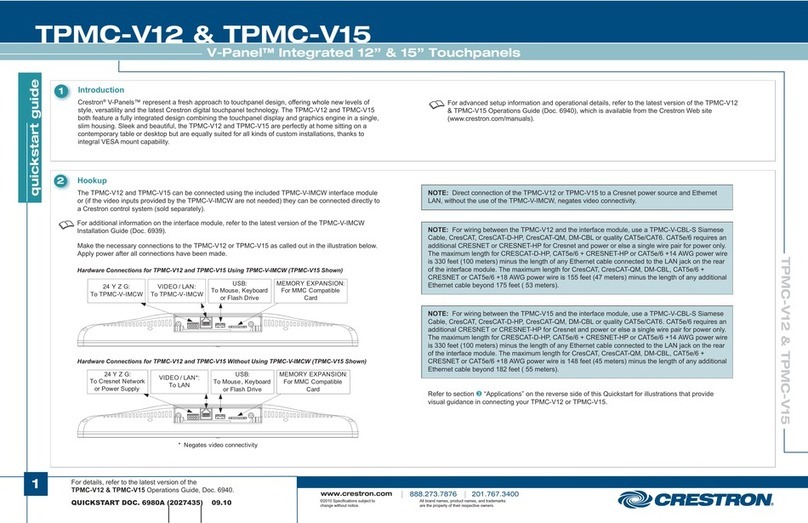
Crestron
Crestron TPMC-V12 & TPMC-V15 quick start guide

AMX
AMX AXT-CV TiltScreen CATP instruction manual

